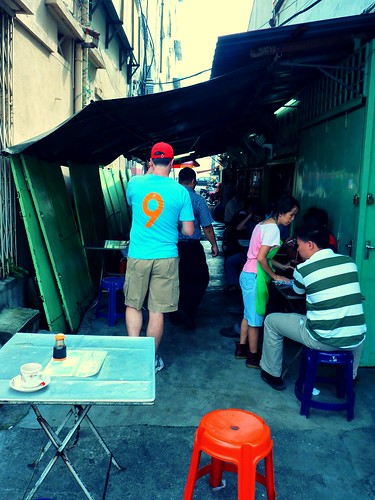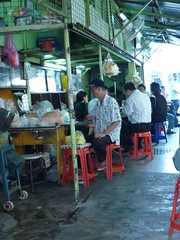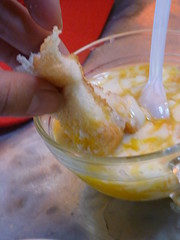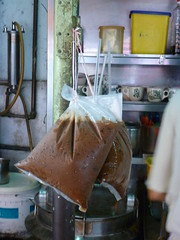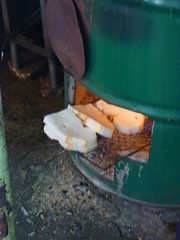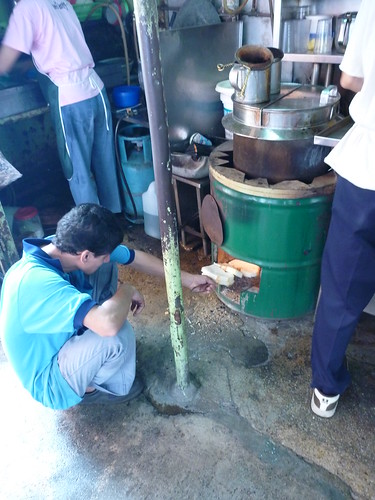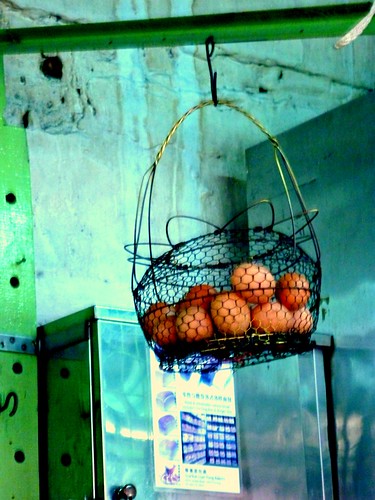
An old twisted wire egg basket swung from an awning above; chatter, clutter, clatter and blurs of colour dominated the scene. Then an explosion of flavor and texture had me transfixed. Every movement in my vicinity seemed to slow to snail’s pace and then as though underwater, I was suddenly locked into my own void of silent discovery.
We were sitting upon low plastic stools at a folding tin topped table, its surface scarred by regular usage. We were in Malaysia. The venue was a narrow laneway, off Campbell Street in Georgetown, Penang. A tarpaulin was stretched overhead, spanning the lane and at the back a makeshift kitchen leant against one wall. The fast paced operation was manned by five people, each allocated their own tasks, two of them servicing two rows of tables.
This is Toh Soon Café. Open from early morning until late afternoon this quaint cobbled together venue is significant in that it’s the last remaining charcoal toasted Roti Bakar venue in Penang.
Roti Bakar is simple: two lightly toasted pieces of extra thick, sweet white bread, sandwiching lashings of butter and Kaya – coconut and egg jam. It comes with two barely boiled eggs which are broken into a cup. A little soy sauce is swirled into the runny eggs and the sweet toasted sandwich is then dipped into the slurry before being raised to your mouth.
In the face of modernisation and electric toasters, this particular stall still toasts the bread over hot coals through a window in a converted ten gallon drum. On our visit a young Indian man hunkered low beside the rustic contraption, toasting two sandwiches at a time, while above the coals the drum contained a chamber for heating the water, blanching the eggs and above that a providing a hotplate for the coffee pot. Simply ingenious - if a little uncomfortable for the staff member on toast duty.
As they say, necessity is the mother of invention, and in this case, it’s also the reason why locals flock here in large numbers when many others also serve Roti Bakar. Because, let’s face it, the turnover is high, the ingredients fresh and tasty, and of course there is the added advantage of eating smoky wood charred toast from a quirky contraption. And given the choice why wouldn’t you?
This, my first experience of Roti Bakar went off like a bomb in my mouth. I was struck dumb as I mentally probed the contents that provided this sensory overload: Crisp then spongy; sweet, salty, slippery; rich, really fresh egg yolk, silky egg white, soy sauce; palm sugar, coconut and more egg enriched unctuousness in the jam.
Crushing the smoky toasted exterior with my teeth, the soft centre of the sliced bread disintegrated on my tongue and the gooey egg, butter, coconut paste combination spread across the palate, soy sauce tipping the balance back from the sweet, rich Kaya.
I don’t think I heard another word spoken until it was finished, and then another round of toast appeared to mop up the rest of the egg.
I could not help myself. In spite of this being my second breakfast - following a nearby Hakka style Yum Cha - I dived into the intensely flavoured mixture of textures, washed down with a rich velvet stream of strong coffee mixed with condensed milk and a hit of chocolate, that left a caramel after taste creeping across my palate. I was temporarily rendered deaf, mute and blind to all around me. I had surely landed in breakfast heaven.
You can also read about Toh Soon Café
at My Wise Wife and Penang Food Galore
